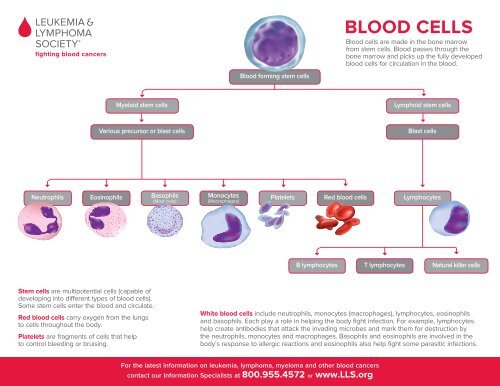Blood Cells/Lymphatic System - The Leukemia & Lymphoma Society
Blood Cells/Lymphatic System - The Leukemia & Lymphoma Society
Blood Cells/Lymphatic System - The Leukemia & Lymphoma Society
You also want an ePaper? Increase the reach of your titles
YUMPU automatically turns print PDFs into web optimized ePapers that Google loves.
<strong>Blood</strong> forming stem cells<br />
BLOOD CELLS<br />
<strong>Blood</strong> cells are made in the bone marrow<br />
from stem cells. <strong>Blood</strong> passes through the<br />
bone marrow and picks up the fully developed<br />
blood cells for circulation in the blood.<br />
Myeloid stem cells<br />
Lymphoid stem cells<br />
Various precursor or blast cells<br />
Blast cells<br />
Neutrophils<br />
Eosinophils<br />
Basophils<br />
(Mast cells)<br />
Monocytes<br />
(Macrophages)<br />
Platelets<br />
Red blood cells<br />
Lymphocytes<br />
B lymphocytes T lymphocytes Natural killer cells<br />
Stem cells are multipotential cells (capable of<br />
developing into different types of blood cells).<br />
Some stem cells enter the blood and circulate.<br />
Red blood cells carry oxygen from the lungs<br />
to cells throughout the body.<br />
Platelets are fragments of cells that help<br />
to control bleeding or bruising.<br />
White blood cells include neutrophils, monocytes (macrophages), lymphocytes, eosinophils<br />
and basophils. Each play a role in helping the body fight infection. For example, lymphocytes<br />
help create antibodies that attack the invading microbes and mark them for destruction by<br />
the neutrophils, monocytes and macrophages. Basophils and eosinophils are involved in the<br />
body’s response to allergic reactions and eosinophils also help fight some parasitic infections.<br />
For the latest information on leukemia, lymphoma, myeloma and other blood cancers<br />
contact our Information Specialists at 800.955.4572 or www.LLS.org
THE LYMPHATIC SYSTEM<br />
Lungs<br />
Heart<br />
Liver<br />
Spleen<br />
Stomach<br />
Large intestine<br />
Small intestine<br />
Ovary<br />
Bladder<br />
Uterus<br />
Bone marrow<br />
PS54 10M 2/12<br />
Lymph node<br />
Lymph vessel<br />
Lymph nodes are small structures<br />
that contain lymphocytes. Lymph<br />
vessels connect the lymph nodes.<br />
Peripheral lymph nodes are near<br />
the surface of the skin and can be<br />
felt by a doctor. Some examples of<br />
peripheral nodes are cervical (head<br />
and neck), axillary (the arm pits),<br />
inguinal (the groin) and popliteal<br />
(lower limbs).<br />
Internal lymph nodes are inside<br />
the body and will show on imaging<br />
tests. Some examples of internal<br />
nodes are mediastinal (the area<br />
between the air sacs of the lungs),<br />
para-aortic (in front of the spine<br />
near the heart), iliac (the pelvic<br />
area) and inguinal (the groin).<br />
For the latest information on leukemia, lymphoma, myeloma and other blood cancers<br />
contact our Information Specialists at 800.955.4572 or www.LLS.org
















